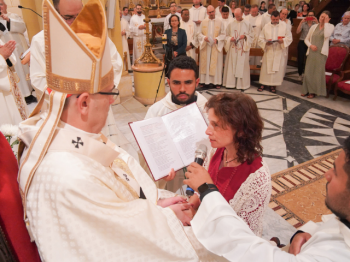The Importance of the Testimony of the Mother Church of Jerusalem in the Liturgy of the Universal Church
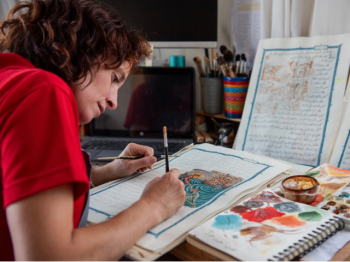
Maria Ruiz is from Spain, a member of the Ordo Virginum, and an iconographer for the Latin Patriarchate of Jerusalem. Maria works alongside the Patriarch of Jerusalem, Cardinal Pierbattista Pizzaballa, on various projects, and with whom she has created the magnificent illustrations of the Arabic-language Missal. Presently, she is working on an Evangeliary that could be made available to all the Churches throughout the world. Your mission, which combines fidelity to Byzantine tradition with contemporary artistic exploration, is supported by the Order of the Holy Sepulchre through the institutional assistance it provides to the Liturgical Office of the Latin Patriarchate
“In this time of deep political and social crisis, we need to place the Word of God once again at the center of the Church’s life in a prophetic way. This is why, starting from Jerusalem where the Word of God became flesh, we are also working on an illustrated Evangeliary, intended first of all for the entire Arab world, and then, through careful translations, for the rest of the world”.
(Maria Ruiz, iconographer in Jerusalem)
What does your mission as an iconographer in Jerusalem consist of?
I have been joyfully working for the Latin Patriarchate of Jerusalem for nearly five years now. I try to serve the proclamation of the Gospel with my brushes. I collaborate concretely with the liturgical office in the creation of images that illustrate liturgical texts, for example, the Missal, the Lectionary, the Rituals. At times, I also provide other services, such as for Cardinal Pizzaballa’s coat of arms, or the jubilee crosses offered as symbols of the Year of Hope in the vast diocese of the Holy Land, which stretches from Jordan to Cyprus
You recently exhibited a series of images created to illustrate the Arabic-language Missal at the Armenian Museum in Jerusalem. With what spirit were these works created, and where did you draw your inspiration?
It is a series of twenty-two images created specifically for the new Arabic-language Missal, which were approved and published at the end of 2022. The theme was assigned to me by the liturgical commission of the Latin Patriarchate. The images were selected together with the Patriarch to illustrate and celebrate the various liturgical seasons (Advent, Christmas, Lent, Easter) and the great solemnities of the Lord and his Mother (Transfiguration, Presentation, All Saints). The originals, later reproduced in the Missal, were displayed in the exhibition. These images are not simply meant to illustrate or decorate the liturgical texts, but in a certain sense, to celebrate the mystery through lines, strokes, and colors. They are like windows or open doors that help the faithful enter into the mystery of the liturgy. This work was carried out with our Christians in mind, as they are the primary recipients of the project. As we know very well, they are facing major challenges, suffering, and immense hardship. For this reason, the color palette is vibrant, the compositions simple yet intuitive, full of vitality and emotion, so they can see with their own eyes that their faith is life, it is joy. It is a source of strength and hope. The technique used is inspired by ancient medieval miniatures: natural pigment with an acrylic binder, Indian ink, and 24-carat gold leaf on parchment paper
The Patriarch gave me a very clear assignment: to find a new style, one that was neither strictly Byzantine nor exclusively medieval Latin, but rich in all the Christian artistic expressions that have passed through the Holy Land since the birth of Christianity. This great challenge required in-depth research...
Where do you draw your inspiration?
I want to emphasize that one of my main sources of inspiration was the Holy Places themselves. Before creating each work, I went to the place where the event is still remembered and celebrated today. These are the first witnesses who still speak in silence. While there, I prayed, read and meditated on the biblical passages related to the scene I was about to depict. The way of working that the Holy Land offers me is unique. In one way or another, we wanted the Holy Places, as we know them, to be identifiable in the images while always keeping in mind, first and foremost, our Christians, who live and pray in those places.




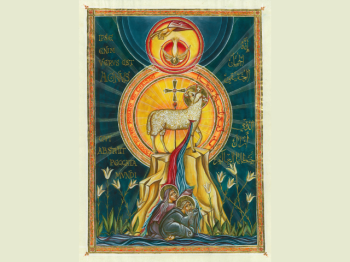
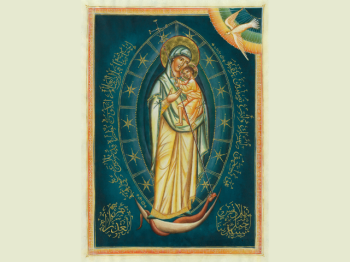
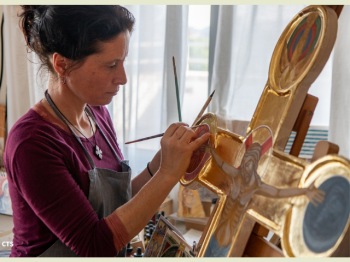 ______ © BM | CTS
______ © BM | CTS
